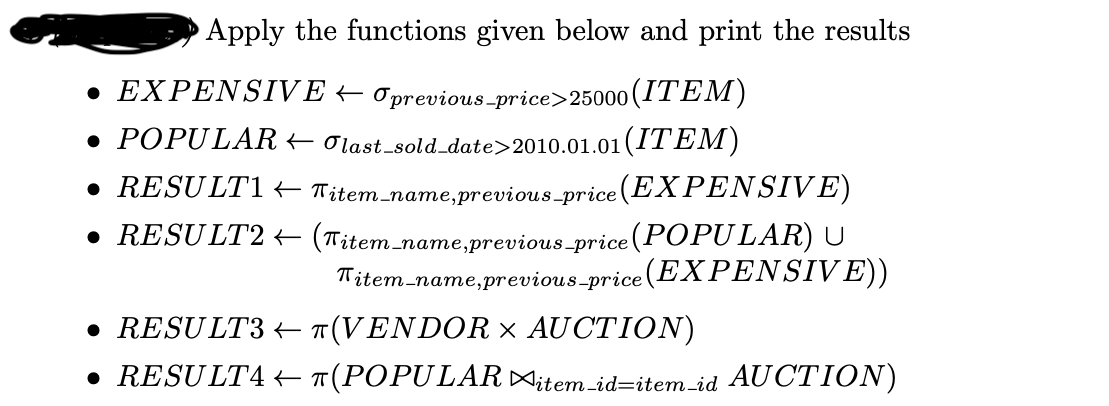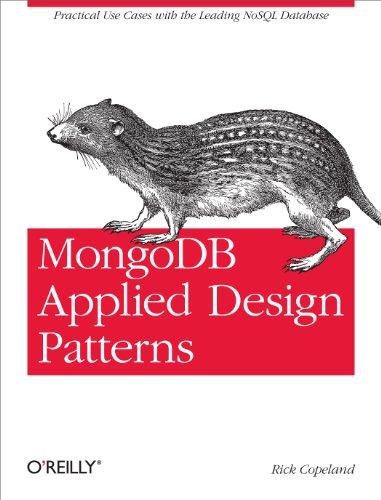Question
WRITE THE CODE OF MYSQL WITH PYTHON PLEASE DO THE FUNCTIONS OF THE QUESTION BY CREATING TABLE AND APPLY THE FUNCTIONS TO THE GIVEN CODE
WRITE THE CODE OF MYSQL WITH PYTHON
PLEASE DO THE FUNCTIONS OF THE QUESTION BY CREATING TABLE
AND APPLY THE FUNCTIONS TO THE GIVEN CODE BELOW!!!
import mysql.connector
# Connect to the MySQL server
cnx = mysql.connector.connect(host="localhost", user="root",
password="Yurtdisi4")
cursor = cnx.cursor()
# Create the 'Market' database
cursor.execute('CREATE DATABASE Market;')
# Use the 'Market' database
cursor.execute('USE Market;')
cursor = cnx.cursor(buffered=True)
# Create the 'Vendor' table
cursor.execute('CREATE TABLE Vendor (vendor_id INTEGER PRIMARY KEY, vendor_name VARCHAR(255), license_start DATE, license_end DATE);')
# Create the 'Item' table
cursor.execute('CREATE TABLE Item (item_id INTEGER PRIMARY KEY, item_name VARCHAR(255), item_type VARCHAR(255), previous_price FLOAT, last_sold_date DATE);')
# Create the 'Auction' table
cursor.execute('CREATE TABLE Auction (auction_id INTEGER PRIMARY KEY, vendor_id INTEGER, item_id INTEGER, price FLOAT, FOREIGN KEY (vendor_id) REFERENCES Vendor(vendor_id), FOREIGN KEY (item_id) REFERENCES Item(item_id));')
sql1 = "INSERT INTO Vendor (vendor_id, vendor_name, license_start, license_end) VALUES (%s, %s, %s, %s)"
val1 = [(1, 'John Smith', '2021-01-01', '2022-12-31'),
(2, 'Melinda Jones', '2021-02-01', '2022-11-30'),
(3, 'Tom Wilson', '2021-03-01', '2022-10-31'),
(4, 'Rachel Williams', '2021-05-01', '2022-09-30'),
(5, 'Adam Johnson', '2021-06-01', '2022-08-31')]
cursor.executemany(sql1, val1)
cnx.commit()
print(cursor.rowcount, "was inserted.")
# We have inserted the tables here
sql2 = "INSERT INTO Item (item_id, item_name, item_type, previous_price, last_sold_date) VALUES (%s, %s, %s, %s, %s)"
val2 = [(11, 'Ball', 'Bronze', 15.50, '2022-12-31'),
(22, 'Jewelery', 'Diamond', 30000.0, '2020-01-23'),
(33, 'Watch', 'Gold', 200.0, '2021-11-30'),
(44, 'Medal', 'Silver', 120.0, '2012-10-06'),
(55, 'Wire', 'Copper', 5.0, '2022-12-15')]
cursor.executemany(sql2, val2)
cnx.commit()
print(cursor.rowcount, "was inserted.")
sql3 = "INSERT INTO Auction (auction_id, vendor_id, item_id, price) VALUES (%s, %s, %s, %s)"
val3 = [(111, 1, 11, 10.0),
(222, 2, 22, 20.0),
(333, 3, 33, 30.0),
(444, 4, 44, 40.0),
(555, 5, 55, 50.0)]
cursor.executemany(sql3, val3)
cnx.commit()
print(cursor.rowcount, "was inserted.")
cursor.execute("SHOW TABLES")
#We apply the function that are required
expensive = ('SELECT previous_price FROM Item WHERE previous_price > 25000');
cursor.execute(expensive)
popular = ('SELECT last_sold_date FROM Item WHERE last_sold_date > 2010-01-01');
cursor.execute(popular)
result1 = ('SELECT item_name, previous_price FROM expensive WHERE item_name, previous_price');
#cursor.execute(result1)
result2 = ('SELECT item_name, previous_price FROM popular, expensive WHERE item_name, previous_price');
#cursor.execute(result2)
result3 = ('SELECT Vendor, Auction FROM Vendor, Auction WHERE Vendor * Auction');
#cursor.execute(result3)
result4 = ('SELECT item_id FROM Popular, Auction WHERE (item_id = item_id)');
#cursor.execute(expensive)
#expensive = cursor.fetchall()
myresult = cursor.fetchall()
#We show their tables
cursor.execute('SELECT * FROM Vendor');
cursor.execute('SELECT vendor_id FROM Auction');
#PRICES
cursor.execute('SELECT price FROM Auction');
cursor.execute('SELECT * FROM Item');
cursor.execute('SELECT * FROM Auction');
#It gives the info
for x in myresult:
print(x)
# Close the connection to the MySQL server
cnx.close()
Step by Step Solution
There are 3 Steps involved in it
Step: 1

Get Instant Access to Expert-Tailored Solutions
See step-by-step solutions with expert insights and AI powered tools for academic success
Step: 2

Step: 3

Ace Your Homework with AI
Get the answers you need in no time with our AI-driven, step-by-step assistance
Get Started


